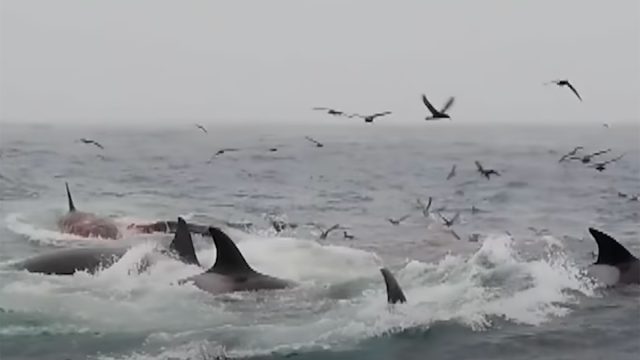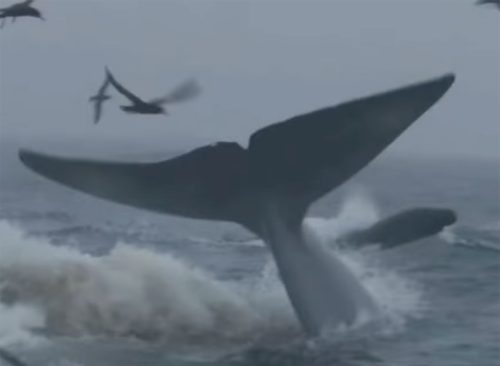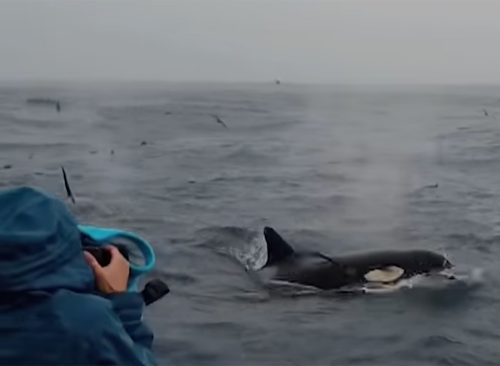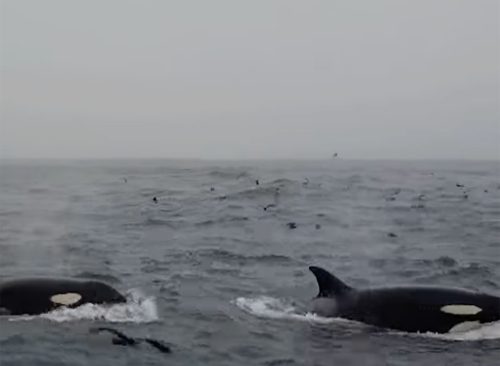Gang of Killer Whales Attacks Blue Whale, The Largest Animal on the Earth. "The Biggest Predation Event on the Planet."
"They know how to do this."

Nature's gonna nature. But that doesn't mean scientists aren't going to be surprised. For them, observing which animals survive the competition of the fittest and which don't is part of the job. But ecologists were shocked when they recently observed a group of killer whales (also known as orcas) attacking and subduing the largest animal on the planet: the blue whale.
"This is the biggest predation event on the planet," said Robert Pitman, a cetacean ecologist at Oregon State University, told Science News. "We haven't seen things like this since dinosaurs were here, and probably not even then." Read on to find out more about the scientists' discovery and another recent finding that indicates their days may be numbered—meaning humans should be worried too.

For decades, scientists weren't sure where killer whales sat in the food chain—were they able and inclined to hunt whales far larger than themselves? On March 21, 2019, a group of Australian scientists saw the answer unfold in front of their eyes. In the Jan. 21 issue of Marine Mammal Science, biologist John Totterdell and colleagues describe what they witnessed.
The research team was en route to their usual orca-observing site when they saw killer whales in the water. "Within seconds, we realized they were attacking something big. Then we realized, oh my, it was a blue whale," said Totterdell.

What the researchers saw: A dozen killer whales assaulting a full-grown blue whale, which was about 60 to 72 feet long. The orcas bit and slammed into the blue whale until it died about an hour later. The scientists say this behavior was similar to what they had observed with other killer whale attacks on large whales.
It was coordinated; the fins, tail and jaw were attacked, possibly to slow the whale; and the whale's head was pushed underwater while others pushed it up to immobilize it. "These are practiced large-whale hunters," said Pitman. "They know how to do this."

The researchers describe other gang attacks involving several of the same whales. In 2019, they hunted a blue whale calf, and a young whale in 2021. The scientists also saw that hunting seems to occur in families. Female orcas frequently lead the hung, with young whales watching and joining in "like excited little puppies," says Pitman. Once the attackers are victorious, the spoils are shared with dozens of other whales.

Orcas also surfaced in the news recently for alarming reasons. Killer whales are an endangered species, and scientists reported that they've found high levels of a "forever chemical" used for processing toilet paper in their bodies. That may be the cause of their dwindling population.
In a recent issue of Environmental Science & Technology, researchers at the University of British Columbia reported the results of tissue analysis from six southern resident killer whales and six Bigg's killer whales stranded along the coast of British Columbia between 2006 and 2018. "They discovered that chemical pollutants are prevalent in killer whales, with a chemical often found in toilet paper one of the most prevalent in the samples studied, accounting for 46 percent of the total pollutants identified," the university said in a statement.

The pollutant at issue is compound 4-nonylphenol (4NP), which is often used in toilet paper production, CNET reports. It's listed as a toxic substance in Canada, which warns it can affect the nervous system and brain. In the U.S., 4NP is a "contaminant of emerging concern," meaning it is not well-studied or well-regulated.
Overall, it's considered a "forever chemical," meaning it does not break down once released into the environment. "This research is a wake-up call," said Juan José Alava, a co-author of the study. "Southern residents are an endangered population and it could be that contaminants are contributing to their population decline. We can't wait to protect this species."














